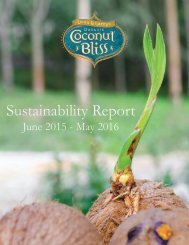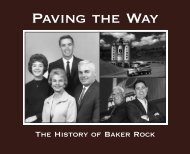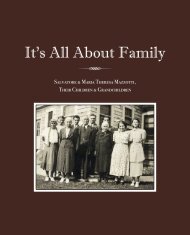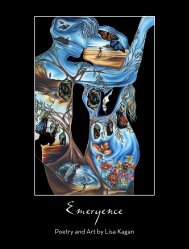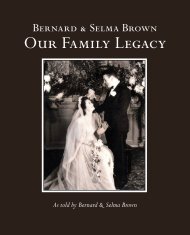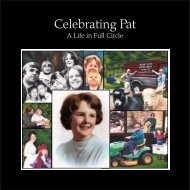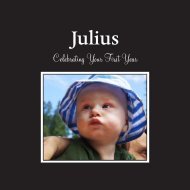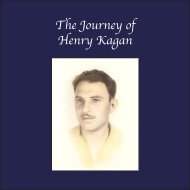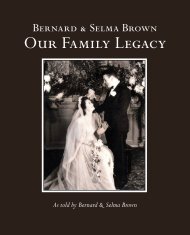Our Family, A Legacy of Twelve Generations
Written by Emily Standish, Produced by Family Heirloom Arts This richly illustrated collection of family stories highlights material from the Civil War up to present day life on the family farm in rural upstate New York. Highlighting stories of perseverance, dedication and hard work, this twelve-generation tale brings to life the ancestral stories of early America and explores the future of family farms in America. Written with heart and humor, this book honors the family relationships and core values that have been passed on from generation to generation.
Written by Emily Standish, Produced by Family Heirloom Arts
This richly illustrated collection of family stories highlights material from the Civil War up to present day life on the family farm in rural upstate New York. Highlighting stories of perseverance, dedication and hard work, this twelve-generation tale brings to life the ancestral stories of early America and explores the future of family farms in America. Written with heart and humor, this book honors the family relationships and core values that have been passed on from generation to generation.
Create successful ePaper yourself
Turn your PDF publications into a flip-book with our unique Google optimized e-Paper software.
<strong>Our</strong> <strong>Family</strong><br />
A <strong>Legacy</strong> <strong>of</strong> <strong>Twelve</strong> <strong>Generations</strong><br />
Emily Stewart Standish
Produced by <strong>Family</strong> Heirloom Arts<br />
www.<strong>Family</strong>HeirloomArts.com<br />
Portland, Oregon<br />
Emily Stewart Standish: Writer, Researcher, Photography Editor<br />
Lisa Kagan: Director, Text Editor, Photography Editor, Book Designer<br />
Connie Lenzen: Genealogist<br />
Emily García: Typographer, Design and Production Assistant<br />
Joseph Webb: Digital Photography Artist<br />
Julie Zander: Copy Editor<br />
Copyright © 2012<br />
Emily Stewart Standish<br />
All rights reserved. Reproduction <strong>of</strong> the whole or any part <strong>of</strong> the contents without permission is prohibited.<br />
Printed by Stevens Printing, Portland, Oregon.<br />
Book binding by Grossenbacher Bros., Inc.<br />
Front Cover Caption:<br />
A collection <strong>of</strong> images celebrating the Stewart family throughout the generations<br />
Cover design by Lisa Kagan.
This collection <strong>of</strong> stories was written by Emily Stewart Standish. A<br />
portion <strong>of</strong> the content for this book is based on oral history interviews<br />
<strong>of</strong> Richard Stewart, which were conducted by Emily Standish from<br />
2010–2012. Source material for this book including letters, journals and<br />
documents were collected from the Stewart family archives.<br />
McBeth family homestead, built 1850
This book is dedicated to my parents and grandparents<br />
in honor <strong>of</strong> their gifts and sacrifices.<br />
May these stories inspire the generations to come.
Contents<br />
Introduction<br />
by Emily Standish<br />
ix<br />
Chapter 1<br />
Origin Stories: The Hart,<br />
Merrell & Green Families<br />
3<br />
Chapter 2<br />
Origin Stories: The McBeth,<br />
Miller & Stewart Families<br />
17<br />
Chapter 3<br />
Alida Green<br />
& E.P. Hart<br />
39<br />
Chapter 4<br />
Peggy Hart<br />
57<br />
Chapter 5<br />
Eldon Stewart<br />
73<br />
S vi S
Chapter 6<br />
Farm Seasons<br />
81<br />
Chapter 7<br />
Eldon Stewart<br />
Later Years<br />
89<br />
Chapter 8<br />
Three <strong>Generations</strong><br />
Living Together<br />
97<br />
Chapter 9<br />
Three Women<br />
Longing<br />
101<br />
Chapter 10<br />
Catskill Chicken<br />
105<br />
Chapter 11<br />
Emily, Richard<br />
& Nancy<br />
111<br />
Chapter 12<br />
One Sentence:<br />
A Journey<br />
135<br />
Chapter 13<br />
All Man’s Land<br />
139<br />
Appendix<br />
Ancestral Charts<br />
143<br />
S vii S
Introduction<br />
by Emily Stewart Standish<br />
“The further backward you can look,<br />
the further forward you are likely to see.”<br />
Winston Churchill<br />
I believe it is important to know where we have<br />
come from, helping us understand how we have gotten<br />
to where we are today. For my family and me,<br />
three hundred years have passed since our Puritan<br />
ancestors settled in Massachusetts Bay, and today our<br />
home in Portland, Oregon, is three thousand miles<br />
away from the family dairy farm in New York State.<br />
With the current geographic, cultural, and digital<br />
divide, our life here seems a long way from the place<br />
I will forever think <strong>of</strong> as “home.”<br />
Yet as I started to delve into the process <strong>of</strong> creating<br />
this book, I began asking myself, “Are we really<br />
so far from our roots?” Researching and writing our<br />
family stories has reminded me over and over that my<br />
ancestors are alive in me, and in my children, nieces,<br />
and nephews, no matter how different our lives may<br />
be. I carry the spirits <strong>of</strong> my grandmother, Alida, and<br />
my mother, Peggy, with me each day. I am constantly<br />
humbled and forever thankful for the legacy that<br />
they have provided without ever having expected<br />
anything in return.<br />
When I was young, the stories <strong>of</strong> the past were<br />
told over and over during family gatherings. I<br />
remember snippets and sentiments <strong>of</strong> some <strong>of</strong> them,<br />
but did not ask the questions then that I would ask<br />
now. I wish I had listened more closely, or better yet,<br />
that I had fired up our old reel-to-reel tape recorder<br />
and captured the sound <strong>of</strong> their voices and their<br />
stories. Over the years stacks <strong>of</strong> family photos, letters,<br />
and memorabilia have been bound with string and<br />
stashed in boxes at the farm, saved by our mothers,<br />
aunts, and grandmothers who probably suspected that<br />
someday we would look to the past in search <strong>of</strong> ourselves.<br />
In the years since their deaths, family members<br />
who shared a reverence for our family stories have<br />
kept these treasures safe.<br />
For the future family history seekers among us<br />
who are still young and pursuing other endeavors, I<br />
wish for you a glimpse at not only our stories, but our<br />
faces. Look into the eyes <strong>of</strong> the men and women coming<br />
to life throughout these pages, and you will see<br />
yourselves emerging miraculously out <strong>of</strong> the generations<br />
<strong>of</strong> Stewarts, Harts, McBeths, and Millers. We<br />
are all here in this book, bound together by our shared<br />
stories and the lineage we carry with us as our family<br />
continues to grow from generation to generation.<br />
S ix S
<strong>Our</strong> <strong>Family</strong><br />
A <strong>Legacy</strong> <strong>of</strong> <strong>Twelve</strong> <strong>Generations</strong>
chapter 1<br />
Origin Stories<br />
The Hart, Merrell & Green Families<br />
When the Puritan settler Stephen Hart boarded the ship Lyon on June 2, 1632, he set<br />
sail for the New World with big dreams <strong>of</strong> religious freedom and the prospect <strong>of</strong><br />
land ownership when he arrived. Lyon was owned by a group <strong>of</strong> Puritan investors and chartered<br />
by Reverend Thomas Hooker to bring settlers to the New World. Stephen Hart could<br />
not have predicted the thousands <strong>of</strong> descendants who would claim him as the first <strong>of</strong> their<br />
family to inhabit what was to become the United States <strong>of</strong> America.<br />
The Hart <strong>Family</strong>,<br />
Settling in the new world<br />
At age twenty-five, Stephen had simple dreams. He<br />
wanted to settle into a life <strong>of</strong> farming with his wife<br />
and family, and worship with other like-minded men.<br />
Stephen Hart is my eleventh great-grandfather.<br />
He was born in Braintree, Essex County, England, in<br />
1605. While still in England, he married his young<br />
sweetheart and they had two children before they set<br />
<strong>of</strong>f across the Atlantic. They landed at Massachusetts<br />
Bay in 1632, and they set up their first home in<br />
Cambridge, Massachusetts. Just a few years later, in<br />
1636, Harvard University would be founded by other<br />
Puritan ministers in the same village.<br />
Stephen and his family went on to follow<br />
Reverend Thomas Hooker to Newtown, Connecticut,<br />
which later became known as Hartford, Connecticut.<br />
At that time, the entire region was inhabited by the<br />
Tunxis Indians and Stephen Hart was among the<br />
first hundred white men to settle in the area. He was<br />
hunting on Talcott Mountain near Hartford when he<br />
glimpsed the fertile Farmington River Valley. Along<br />
with a few dozen other residents <strong>of</strong> Hartford, he<br />
moved his growing family to the Farmington River<br />
Valley and helped to build a town on the east side <strong>of</strong><br />
the river. The town was incorporated as Farmington<br />
Facing page: Alida, Anna Merrell, Edmund Matthew,<br />
and Stanley Hart, circa 1905<br />
S 3 S
College, a women’s college in Columbia, Missouri.<br />
It was a difficult decision to leave Edmund behind<br />
in New York State while she pursued a career, so she<br />
wrote to Edmund about the choices that she faced.<br />
Anna ultimately decided to travel west to teach<br />
at Stevens College but they became engaged before<br />
she left. While there, she missed Edmund and fretted<br />
over the distance that separated them.<br />
I thought I would not write until I<br />
could tell you what my decision was<br />
which I could not determine until<br />
I returned to Bath. I received a letter<br />
from New York informing me <strong>of</strong><br />
a vacancy at Groton, New York and<br />
I wrote to inquire but have received<br />
no answer. When I am settled again I<br />
will write you such long letters. And<br />
wherever I am I shall be yours only<br />
and forever. If I go west which will not<br />
be this week, I will write you when to<br />
meet me.<br />
I have so much to say to you darling,<br />
but I cannot say it now for I want you<br />
to get this letter tomorrow, but your<br />
kind heart will forgive, when my mind<br />
is not so ill at ease I will write you a<br />
long long letter. But now my Dearest I<br />
must say au revoir.<br />
Lovingly,<br />
Your Annie<br />
– Adapted from a letter from Anna Merrell to Edmund, written<br />
December 20, 1869<br />
Excerpts from Anna’s diary, Wednesday, March 13, 1872:<br />
This is a sad day. I have not received<br />
a letter from Edmund in over a week.<br />
Have been asking myself over and over<br />
again if I could give him up. I don’t see<br />
why I feel so but it has been impressed<br />
upon my mind for so long that this<br />
would invalidate our engagement. God<br />
help me to endure anything and to say,<br />
“He leadeth me.”<br />
Friday, March 15, 1872:<br />
Received a letter from Edmund, a<br />
darling little letter assuring me <strong>of</strong> his<br />
love. I think love is the dearest trait <strong>of</strong><br />
a human character. My mind is at rest.<br />
Thursday, March 21, 1872:<br />
How the time is passing. Soon the<br />
time will come that is to make me<br />
happy or miserable, happy, I think.<br />
Precious dear!<br />
After a long and passionate courtship, Anna left<br />
her teaching duties at Stevens and returned by train<br />
to Hornell, where she and her beloved Edmund were<br />
married on September 2, 1872. Two years later, they<br />
had a baby boy who they named Edmund Percival<br />
Hart, and they called him “Percy.” They settled in<br />
Hornell, New York, in a big house with a shady front<br />
porch at Number 19 Ravine Street. Edmund Percival<br />
was my grandfather.<br />
Anna and Edmund had another son, Stanley, several<br />
years later. Edmund and Anna were active in the<br />
S 7 S
Marriage certificate, recognizing the marriage <strong>of</strong> Edmund Hart and Anna Merrell, September 2, 1872<br />
S 8 S
Robert McBeth<br />
S 22 S
A Collection <strong>of</strong> Civil War Letters<br />
Robert we were sorry to hear that<br />
you are wounded but we are very<br />
thankful it was no worse, that when<br />
the rebel bullets was permitted to come<br />
so near you that a life has been spared.<br />
It shows you and us that The Great<br />
Preserver is ever near. He that watches<br />
over the fall <strong>of</strong> the sparrow will watch<br />
over you and we hope bring you back<br />
home to us in peace and safety.<br />
– Adapted from a letter to Robert McBeth from his mother,<br />
Mary Miller McBeth, April 22, 1865<br />
It was joyful tiding for us to hear<br />
that Petersburg and Richmond was<br />
ours and that Lee had surrendered but<br />
oh how soon there was a change from<br />
joy to sorrow. Those came a sound as<br />
word on the winds that our President<br />
is Dead, felled by the hands <strong>of</strong> an<br />
assassin. We was at your grandpa’s<br />
when your Aunt Jane came in and<br />
asked us if we had seen the flag half<br />
masted. She said that Mr. Lincoln was<br />
Dead. We have heard that the murderer<br />
<strong>of</strong> our President was surrounded<br />
but they could not take him alive.<br />
They were obliged to shoot him.<br />
– Adapted from a letter to Robert McBeth from his mother,<br />
Mary Miller McBeth, April 22, 1865<br />
Your pa received the papers that you<br />
sent him yesterday. We hope that you<br />
will write to us as soon as you receive<br />
this and tell us whether you expect to<br />
be returned to your regiment or to be<br />
returned home. We cannot see why<br />
you would be sent home. We have<br />
heard that Sherman has made a bad<br />
move which has discouraged us some<br />
but we know that He Who Rules and<br />
ever Rules will do all things Right.<br />
– Adapted from a letter to Robert McBeth from his mother,<br />
Mary Miller McBeth, April 22, 1865<br />
Dear Son,<br />
We rejoice to hear that you escaped<br />
with so slight a wound. We commit<br />
you to that care which has shielded<br />
you. You will find five dollars within.<br />
The money you sent came all right, the<br />
box you sent has not come yet. Write<br />
son, your father, and let us know if you<br />
have seen President Johnson. See all the<br />
government <strong>of</strong>ficers and let us know<br />
how they look. Write soon and send us<br />
all the particulars <strong>of</strong> all you see.<br />
Yours affectionately<br />
– Adapted from a letter to Robert from his father, James McBeth,<br />
April 24, 1865<br />
S 23 S
Civil War letter written by Mary Miller McBeth to her son Robert<br />
S 24 S
S 25 S
Nancy McBeth<br />
S 28 S
Mabel Miller<br />
S 29 S
The Stewart <strong>Family</strong><br />
In 1805 my great-great-great-grandparents, John<br />
Stewart and his wife, Jane White, emigrated from<br />
County Cavan, Ireland, to America. They settled first<br />
in Albany, New York. Not long after they arrived,<br />
John was taken sick and had to be hospitalized. He<br />
was visited in the hospital by two men who were<br />
members <strong>of</strong> the Masonic Lodge. He entrusted them<br />
with his money for safekeeping while he was recovering<br />
in the hospital. According to family lore, the two<br />
men absconded with the money and he never saw<br />
them again.<br />
Eventually, after his recovery, John<br />
moved his family to Argyle, Washington<br />
County, New York, and then on to<br />
Steuben County in 1818. They settled on<br />
a tract <strong>of</strong> 150 acres in the tiny village <strong>of</strong><br />
Howard. John found land for fifty cents<br />
per acre that he was interested in purchasing<br />
near the village <strong>of</strong> Bath. Instead, he<br />
eventually bought the tract in Howard for<br />
$3.50 per acre because the Bath property<br />
was reputed to be full <strong>of</strong> rattlesnakes.<br />
John, known as “Bully Jack,” was reputed<br />
to have a double row <strong>of</strong> teeth on top and<br />
bottom, making it possible for him to bite<br />
a shingle nail in two.<br />
John and Jane had two known children,<br />
Mary Jane and William. William was a<br />
farmer until age forty-five, then studied<br />
under a local doctor and practiced medicine<br />
in the town <strong>of</strong> Howard until his death<br />
in 1898. William’s wife was Susan Lucretia<br />
Ford, a descendent <strong>of</strong> the Ford family who<br />
had been in Massachusetts since the mid-<br />
1600s. William and Susan had thirteen<br />
children, four <strong>of</strong> whom died before they<br />
were five years old. The children who survived<br />
to adulthood were Robert, Melissa,<br />
Mabel and Elma Miller<br />
Matilda, Samuel Edgar, William Ford, James Hall,<br />
Susan Jane, Olive Ada, and Fanetta. Samuel Edgar<br />
was my great-grandfather. He married Mary Jane<br />
Watts and they had five children. One <strong>of</strong> Edgar and<br />
Mary Jane’s children was Jackson Lee Stewart, born<br />
in 1882.<br />
Mabel Miller married Jackson Lee Stewart in<br />
1912 and they bought the sixty-three acres and the<br />
farmhouse from Mabel’s Uncle Robert, the Civil War<br />
veteran. On August 31, 1911, Mabel’s brother Floyd<br />
noted in his diary, “Jack and Robert went to Bath<br />
S 30 S
Samuel Edgar Stewart, circa 1870<br />
S 31 S
chapter 3<br />
Alida Green<br />
& E.P. Hart<br />
Alida May Green was all too familiar with leaving her loved ones behind, and, in 1901,<br />
she stepped fearlessly onto the train in noisy, gritty Hornell, New York, traveling east<br />
to pursue a college education. For two years she had been teaching elementary school, saving<br />
money to finance the college classes she dreamed <strong>of</strong> attending someday. The Erie Railroad<br />
car she boarded was bound for Providence, Rhode Island, where the Women’s College <strong>of</strong><br />
Brown University was just ten years young.<br />
The first women had only begun taking classes<br />
at Brown in 1891, though men had been matriculating<br />
there since 1764. Brown was not the only college<br />
educating young women at the time, but one compelling<br />
reason brought Alida to Providence: her oldest<br />
sister, Alice Green Carr, kept a boarding house there<br />
for Brown University boys. Alida could live with her<br />
sister, help with housekeeping to defray room and<br />
board expenses, and teach night school to help pay her<br />
college tuition. Imagine Alida stepping <strong>of</strong>f the train in<br />
a new city, beginning a course <strong>of</strong> college classes that<br />
very few women at the time would have access to, and<br />
living with a half-dozen college boys!<br />
’Lida was the “baby” <strong>of</strong> her family, the eighth<br />
child born to Luke and Olive Monroe Green in<br />
Alfred, New York. Her arrival in 1881 came at a time<br />
when the lives <strong>of</strong> rural families were defined by their<br />
work, their church, their family, and their neighbors.<br />
Even though the United States had just survived the<br />
bloodiest and most tumultuous time in its hundredyear<br />
history, the day-to-day lives <strong>of</strong> Alida’s family<br />
were rarely affected by the issues <strong>of</strong> the young nation.<br />
Instead, their daily routines were dictated by growing,<br />
harvesting, and “putting by” enough food for a large<br />
family to survive long, bitter-cold winters. The clothes<br />
worn by the family were the result <strong>of</strong> spinning enough<br />
Facing page: A collection <strong>of</strong> photos <strong>of</strong> Alida and E.P. Hart,<br />
with a postcard <strong>of</strong> Hornell, New York<br />
S 39 S
Card celebrating Peggy and Eldon’s engagement<br />
Peggy and Eldon’s wedding announcement<br />
After her graduation from college, Peggy moved<br />
back home and began teaching home economics,<br />
including an evening class in Canisteo, New York.<br />
Peggy’s cousin, Wayne Crandall, was also a teacher<br />
in the evening school. Wayne introduced Peggy to<br />
Eldon Stewart, a young farmer who was a student<br />
there. Wayne may have recognized qualities that both<br />
Peggy and Eldon possessed, their curiosity about the<br />
world and their gregarious personalities. Peggy and<br />
Eldon dated for two years, going to movies and playing<br />
cards with friends, sandwiched in between Eldon’s<br />
demanding schedule <strong>of</strong> farm work. Before long my<br />
parents, Peggy and Eldon, were engaged and had set<br />
a wedding date for August 16, 1942. An engagement<br />
party was held in the back yard <strong>of</strong> Peggy’s childhood<br />
home at 153 Seneca Street, the same yard where she<br />
and her siblings had chased fireflies years before. My<br />
parents’ wedding was small and my mother handwrote<br />
all the invitations to her family.<br />
When Peggy and Eldon married, they moved into<br />
his family home on the farm. At this same juncture,<br />
his family home acquired electricity for the first time.<br />
Until then my grandparents had used a generator to<br />
create light in the evenings, but they thought that a<br />
college-educated daughter-in-law would be expecting<br />
electricity! They lived in the tiny upstairs <strong>of</strong><br />
the farmhouse with a kitchen and three bedrooms.<br />
When several guests came for a special meal, such as<br />
Christmas or Easter, Eldon would switch the furniture<br />
between rooms, placing the tiny kitchen table in<br />
a bedroom to create an actual dining room. Peggy’s<br />
family gifted them many special household items for<br />
their wedding, so they would have everything they<br />
needed to set up their new home and be able to host<br />
family and friends over the years.<br />
Once their space was set up and settled in, Peggy<br />
was eager to embark on the journey <strong>of</strong> becoming a<br />
mother. Their first baby girl, Nancy, was born on<br />
March 24, 1944, within two years <strong>of</strong> their wedding.<br />
S 62 S
Eldon and Peggy, Easter 1941<br />
S 63 S
chapter 5<br />
Eldon Stewart<br />
This story includes excerpts from the diary <strong>of</strong> my father, Eldon Stewart. He recorded entries daily when he was fifteen years old.<br />
W<br />
hen my father, Eldon, looked down at the bed pushed against the wall in Mrs. Day’s<br />
hallway, he knew he would be figuring out a lot <strong>of</strong> things for himself that semester.<br />
If he resolved to make the best <strong>of</strong> himself, it was going to be his decision. He was fifteenand-a-half<br />
and would be a boarder at Mrs. Day’s from Sunday evening to Friday afternoon.<br />
He would stay there from January until the end<br />
<strong>of</strong> the school year in June. Due to the harsh winters<br />
in upstate New York, he had to live close to school in<br />
order to make sure he could keep up regular attendance.<br />
After the summer he hoped he would have his<br />
license and occasionally be able to drive himself to<br />
school. For now though, he would sleep on this bed<br />
in this hallway and put his few clothes in a box at the<br />
foot <strong>of</strong> the bed.<br />
Even though in January <strong>of</strong> 1932, the Great<br />
Depression was still lingering and the farm needed<br />
all the strong hands it could get, it was decided that<br />
all the Stewart children would finish high school.<br />
In those days in that area sustained by farming,<br />
Sunday, January 3, 1932:<br />
Done chores, got ready and went<br />
to church. Leon brought me here to<br />
Canisteo about 4:00. Went to church<br />
again, got home about 9:00. I have my<br />
bed in the hall at Mrs. Day’s. Resolved<br />
that I will make the best <strong>of</strong> myself.<br />
education was not a given. The nearby Dublin<br />
schoolhouse, a one-room school, educated students<br />
only through the eighth grade. Eldon’s parents, Jack<br />
and Mabel, decided that would not be a sufficient<br />
Facing page: Photos <strong>of</strong> Eldon Stewart<br />
with his teenage diary entries<br />
S 73 S
chapter 11<br />
Emily, Richard<br />
& Nancy<br />
It is easy to fantasize about the idyllic life growing up on a farm, but as a young person I<br />
rarely thought <strong>of</strong> it that way. As a teenager, I could not wait to leave that life behind.<br />
Now, as a grown woman, I am more inclined to remember the good and filter out the parts<br />
that I felt were confining when I was growing up. For me, up until high school, I really<br />
enjoyed my lifestyle on the farm. I had my cats, a dog, acres to roam, fresh and plentiful<br />
food, and cousins nearby to play with.<br />
Emily<br />
In one <strong>of</strong> my earliest memories <strong>of</strong> life on the farm,<br />
I recall a litter <strong>of</strong> kittens born in my bedroom closet<br />
when I was about three years old. The blessed event<br />
happened while I was asleep and I heard my mother<br />
and sister whispering and gesturing at something in<br />
the closet. No doubt they had been watching for signs<br />
<strong>of</strong> the impending births, and when the time came<br />
they wanted to be there too. I awoke to their voices<br />
and joined in to witness this miracle <strong>of</strong> life. I trace<br />
my enduring love <strong>of</strong> cats to that moment. Later, I<br />
adored the family cat that we simply called “Mama<br />
Kitty,” and doted on each successive litter <strong>of</strong> kittens<br />
she provided. I would follow her into the haymow to<br />
the spot she had chosen to raise her litter to their own<br />
self-sufficiency, and she would reward me by allowing<br />
me to handle the new babies under her supervision.<br />
I treasured my cats and a succession <strong>of</strong> dogs,<br />
Penny, then Lady, then the last one we called Butch.<br />
These dogs were a shaggy mix <strong>of</strong> shepherd and collie.<br />
They were trained to dash to the upper field where the<br />
cattle were grazing, and herd the cows to the barn at<br />
the sound <strong>of</strong> my father clapping. They were trained in<br />
this way because <strong>of</strong> my father’s laryngectomy, which<br />
made him unable to call out orders for the dogs to<br />
“go get the cows.” I tried to train them to do other<br />
Facing page: A collection <strong>of</strong> childhood photos<br />
<strong>of</strong> Emily, Richard, and Nancy<br />
S 111 S




